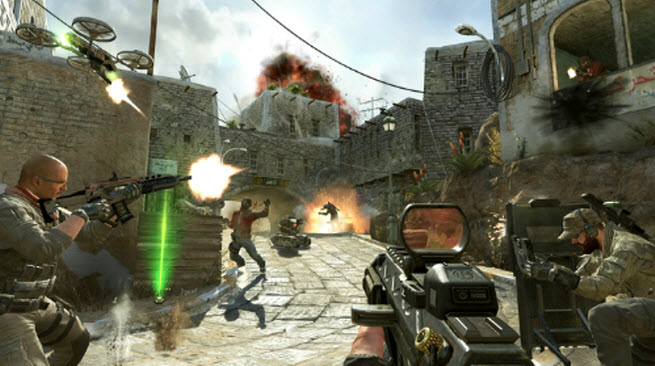Activision Blizzard has a lot at stake with the multiplayer mode of the upcoming Call of Duty: Black Ops II. If the game lives up to past titles in the modern combat series, it will have to sell millions of copies in its first week and generate more than billion dollars in retail revenue. Key to this game’s success is the multiplayer design, which will determine whether hardcore fans will stay with the game for months or even years. That’s why we’re excited to finally talk about how the multiplayer version of this game really works.
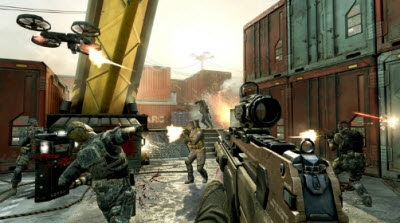 Black Ops II won’t hit until Nov. 13, but Activision is busy stoking demand for the game with a slow striptease for gamers. It is unveiling the hands-on multiplayer demo today at the Gamescom show in Cologne, Germany. I got my hands on the multiplayer gameplay and it felt both familiar and novel all at the same time. To me, it has lots of cool innovations that will make fans of the series happy. It has changes that veterans will scream bloody murder about, but all of us will have the same challenge of getting used to playing Call of Duty multiplayer in new ways.
Black Ops II won’t hit until Nov. 13, but Activision is busy stoking demand for the game with a slow striptease for gamers. It is unveiling the hands-on multiplayer demo today at the Gamescom show in Cologne, Germany. I got my hands on the multiplayer gameplay and it felt both familiar and novel all at the same time. To me, it has lots of cool innovations that will make fans of the series happy. It has changes that veterans will scream bloody murder about, but all of us will have the same challenge of getting used to playing Call of Duty multiplayer in new ways.
Dan Bunting, the director of online at game developer Treyarch, believes that the team has to kill its own babies in order to move forward and innovate. The team wanted to revolutionize the combat in Black Ops II, so it was willing to change the multiplayer gameplay that wasn’t broken. Treyarch got rid of things that were considered sacrosanct in previous games.
While the Black Ops title from two years ago took place in the Cold War of the 1960s, this game is set in 2025 and features cutting-edge weaponry that will feel like science fiction.
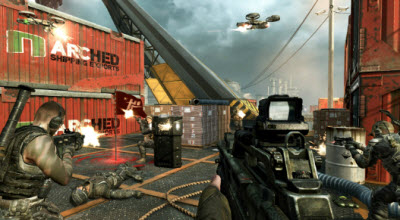 One of the big changes is in the overhaul of the “Create a Class” feature. This is where you customize your kit so that you can choose your primary weapon, secondary weapon, special abilities known as “perks,” accessories such as stun grenades, and your camouflage. Now you no longer have to accept the categories the game gives you. You had to fill the three perk slots with something.
One of the big changes is in the overhaul of the “Create a Class” feature. This is where you customize your kit so that you can choose your primary weapon, secondary weapon, special abilities known as “perks,” accessories such as stun grenades, and your camouflage. Now you no longer have to accept the categories the game gives you. You had to fill the three perk slots with something.
But not anymore. Instead, you get to pick 10 items and allocate them any way that you want. You can trade items from one category for extra items in another. This gives you many more choices for customization than you’ve ever had. You get a budget and decide what you want to take into battle, within the constraints of that budget. You’re essentially getting more creativity in designing your own class. If you want to equip your primary weapon with three attachments, you can do so, but you may not have any points to spend on a secondary weapon. I played with a class where I could dual-wield pistols, was tougher to kill, and could use a sniper rifle with three attachments (like a scope).
The game will also feature a new Score streaks system. These Score streaks reward players for helping their team win the game. They include actions such as capturing a flag, defending a teammate with an assault shield, and getting kills and assists. Each action has a different value and can influence the overall theater of operations. This system replaces the Killstreak system in the previous game, where skillful players were rewarded with powerful one-time advantages such as a drone strike. In this system, the rich got richer. The players that always got kills simply got even more kills with the Killstreak system. It was fun, but it wasn’t really fair to the weaker players.
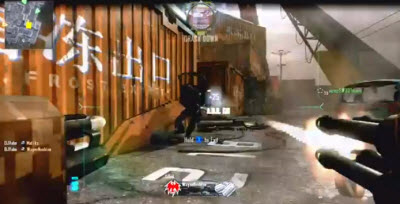 With Score streaks, all players contribute to a greater good. If you do something to help the team, your Score streak meter rises. You could play an entire round and not get a single kill. But if you defend your teammates, you can get points and cash them in with a one-time bonus such as an unmanned aerial vehicle (UAV) that reveals the locations of the enemy on the map. It’s about doing things that help your team win. You can stack rewards up and still keep them balanced.
With Score streaks, all players contribute to a greater good. If you do something to help the team, your Score streak meter rises. You could play an entire round and not get a single kill. But if you defend your teammates, you can get points and cash them in with a one-time bonus such as an unmanned aerial vehicle (UAV) that reveals the locations of the enemy on the map. It’s about doing things that help your team win. You can stack rewards up and still keep them balanced.
You can also win items such as aerial drones (dubbed the MQ-27 quad rotor drone) that you can pilot remotely so that you can kill from above. Or you can let the drones run on autopilot and do the killing for you while you control your soldier on the ground. You can set loose an AGR (autonomous ground robot) to walk around and shoot. Or (as pictured above), you can get inside it and control where it goes and what it shoots at.
You can also call in an A10 tank-killer aircraft and watch it do a bombing run. The pilot of the aircraft stays in radio contact with you and describes the results of the bomb run. And a Lightning Strike lets you target three areas and launch aerial strikes on them. In the past, you could call in a bombing run. But the results were only visible as numerical points flashed on the screen as the enemy gets killed.
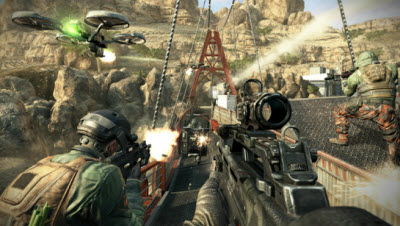 Black Ops II’s multiplayer boosts some new weapons, such as the Microwave Turret. That’s a high-powered weapon used for crowd control. It emits an intense directed energy wave, and it is used to block routes that the enemy might take. You can also use a Swarm, which is a bunch of hunter-killer drones that can attack enemies in a big swarm. Another new weapon is the War Machine, an übergrenade launcher; and The Death Machine, a handheld Gatling gun. You can commandeer a Hellstorm Missile and guide it to its path, or you can deploy a bunch of cluster bombs and take out multiple enemies. You can also take control of a Vertical Take-Off and Landing (VTOL) aircraft and rain gunfire from above.
Black Ops II’s multiplayer boosts some new weapons, such as the Microwave Turret. That’s a high-powered weapon used for crowd control. It emits an intense directed energy wave, and it is used to block routes that the enemy might take. You can also use a Swarm, which is a bunch of hunter-killer drones that can attack enemies in a big swarm. Another new weapon is the War Machine, an übergrenade launcher; and The Death Machine, a handheld Gatling gun. You can commandeer a Hellstorm Missile and guide it to its path, or you can deploy a bunch of cluster bombs and take out multiple enemies. You can also take control of a Vertical Take-Off and Landing (VTOL) aircraft and rain gunfire from above.
One of the cool new features is that you can have up to six teams fighting each other in a single game. You can have up to 18 players per match, so you could have six teams of three players each, all fighting each other.
Activision showed maps including Aftermath, Turbine, and Cargo. The levels included all of the graphics upgrades, such as better lighting in which light appears to bounce off a floor or an object and illuminate something else that the bounced light rays hit.
Aftermath takes place in downtown Los Angeles after a drone strike. It’s a medium-sized map in which the best tactic is to stay with your teammates. I played this one as a “mercenary class” soldier with an assault gun. The obvious change that I saw almost immediately was the Target Finder, a reticle that will give you quick identification of a friend or foe when your gunsight moves over another person. This reticle really helped me fix my sights on enemies quickly and shoot them faster. For players that aren’t that good, this is a godsend. It will help equalize the game against those with the fastest reactions.
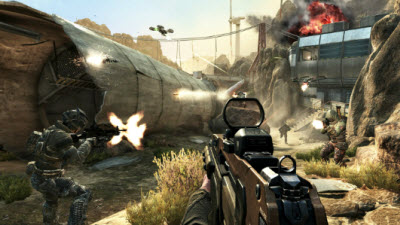 The Turbine map is set in Yemen and is an outdoor desert with a wind farm. Cargo is a smaller map set in the port of Singapore where cranes are picking up cargo from ships; you have to deal with constantly moving cargo containers.
The Turbine map is set in Yemen and is an outdoor desert with a wind farm. Cargo is a smaller map set in the port of Singapore where cranes are picking up cargo from ships; you have to deal with constantly moving cargo containers.
The near-future setting means there are plenty of upgrades in technology. You can use Assault Shields that give you cover. A Millimeter Wave Scanner shows stationary targets and close range and through surfaces. (If you’re a camper or someone who hides behind cover and picks off those running by, this is bad for you). A Shock Charge (shown in the video below) is a nonlethal device that you throw into the ground, and it electrocutes and stuns enemies that come near it. On your weapon, you have a Laser Sight that gives you a fix on your target but is visible to other soldiers.
The multiplayer version of the game is also designed for eSports, or professional game tournaments. The League Play feature is built right into the game; it allows you to compete for prizes with people who are at a similar skill level. If you are the top player in the world, you will compete against others who are just as good in the rankings.
Another feature is Shoutcasting, where players can follow a tournament that is narrated by a “shoutcaster,” or commentator who knows the game well. The tools for Shoutcasting are built right into the dashboard of the game. The goal is to turn Call of Duty into a spectator sport. Since 30 million people play Call of Duty, Treyarch hopes the eSports version of Call of Duty will be bigger than Monday Night Football some day. The game will teach players how to be play-by-play shoutcasters.
The spectator features include a picture-in-picture view that shows a list of everyone in the game, their current Score streak, and their status. The Map View shows both sides of the battle from a top-down perspective. The Score Panel shows the big picture of one team’s stats versus another’s. As a spectator, you can listen in on the player conversations as the action happens, too.
The last major feature is Live Streaming, which will make it more fun to watch a competitive match as it happens. Right now, it costs hundreds of thousands of dollars to set up your own live streams. But the live streaming feature will be built directly into the game dashboard, eliminating that cost for gamers.
Call of Duty: Black Ops II debuts Nov. 13 on the PC, Xbox 360 and the PlayStation 3. I’m looking forward to all of the new ways to kill other players in Black Ops II. I think current fans are going to love it.
VentureBeat's mission is to be a digital town square for technical decision-makers to gain knowledge about transformative enterprise technology and transact. Learn More
